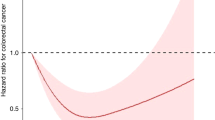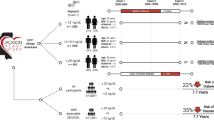Abstract
Background
A higher circulating vitamin D level is inversely associated with the risk of colorectal cancer, but the association with adenoma risk is less clear.
Aims
We examined the association between the circulating 25-hydroxyvitamin D3 [25(OH)D3] concentration and colorectal adenoma in asymptomatic average-risk participants undergoing initial screening colonoscopy.
Methods
The study subjects were comprised of 143 cases of colorectal adenomas and 143 age- and gender-matched controls with normal colonoscopy among the 586 asymptomatic average-risk subjects (median age, 58 years; range, 50–73 years) who underwent first screening colonoscopy and measurement of the serum 25(OH)D3 between December 2009 and April 2010, consistent with winter months of the region.
Results
The mean concentration of serum 25(OH)D3 in the adenoma and control groups was 20.0 ± 11.0 ng/ml and 25.0 ± 20.0 ng/ml, respectively (P = 0.009). Using multivariate analysis, higher levels of 25(OH)D3 were associated with a statistically significant decreased risk of colorectal adenoma after multivariable adjustment (highest vs. lowest quartile OR 0.38, 95% CI 0.18–0.80, P trend = 0.012). The inverse association of circulating 25(OH)D3 with colorectal adenoma was stronger among the patients with proximal adenoma than that among the patients without proximal adenoma (highest vs. lowest quartile OR 0.29, 95% CI 0.13–0.66, P trend = 0.001).
Conclusions
The present study suggests that high levels of circulating vitamin D are associated with a decreased risk of colorectal adenoma, and especially adenoma located in the proximal colon.

Similar content being viewed by others
References
Garland CF, Garland FC. Do sunlight and vitamin D reduce the likelihood of colon cancer? Int J Epidemiol. 1980;9:227–231.
Matusiak D, Murillo G, Carroll RE, Mehta RG, Benya RV. Expression of vitamin D receptor and 25-hydroxyvitamin D3–1{alpha}-hydroxylase in normal and malignant human colon. Cancer Epidemiol Biomarkers Prev. 2005;14:2370–2376.
Tangpricha V, Flanagan JN, Whitlatch LW, et al. 25-hydroxyvitamin D-1alpha-hydroxylase in normal and malignant colon tissue. Lancet. 2001;357:1673–1674.
Miller EA, Keku TO, Satia JA, Martin CF, Galanko JA, Sandler RS. Calcium, vitamin D, and apoptosis in the rectal epithelium. Cancer Epidemiol Biomarkers Prev. 2005;14:525–528.
Diaz GD, Paraskeva C, Thomas MG, Binderup L, Hague A. Apoptosis is induced by the active metabolite of vitamin D3 and its analogue eb1089 in colorectal adenoma and carcinoma cells: possible implications for prevention and therapy. Cancer Res. 2000;60:2304–2312.
Holick MF, Chen TC. Vitamin D deficiency: a worldwide problem with health consequences. Am J Clin Nutr. 2008;87:1080S–1086S.
Hanley DA, Davison KS. Vitamin D insufficiency in North America. J Nutr. 2005;135:332–337.
Prentice A, Goldberg GR, Schoenmakers I. Vitamin D across the lifecycle: physiology and biomarkers. Am J Clin Nutr. 2008;88:500S–506S.
Wei MY, Garland CF, Gorham ED, Mohr SB, Giovannucci E. Vitamin D and prevention of colorectal adenoma: a meta-analysis. Cancer Epidemiol Biomarkers Prev. 2008;17:2958–2969.
Whelan RL, Horvath KD, Gleason NR, et al. Vitamin and calcium supplement use is associated with decreased adenoma recurrence in patients with a previous history of neoplasia. Dis Colon Rectum. 1999;42:212–217.
Boutron MC, Faivre J, Marteau P, Couillault C, Senesse P, Quipourt V. Calcium, phosphorus, vitamin D, dairy products and colorectal carcinogenesis: a French case–control study. Br J Cancer. 1996;74:145–151.
Peters U, McGlynn KA, Chatterjee N, et al. Vitamin D, calcium, and vitamin D receptor polymorphism in colorectal adenomas. Cancer Epidemiol Biomarkers Prev. 2001;10:1267–1274.
Levine AJ, Harper JM, Ervin CM, et al. Serum 25-hydroxyvitamin D, dietary calcium intake, and distal colorectal adenoma risk. Nutr Cancer. 2001;39:35–41.
Boyapati SM, Bostick RM, McGlynn KA, et al. Calcium, vitamin D, and risk for colorectal adenoma: dependency on vitamin D receptor Bsmi polymorphism and nonsteroidal anti-inflammatory drug use? Cancer Epidemiol Biomarkers Prev. 2003;12:631–637.
Kampman E, Giovannucci E, van’t Veer P, et al. Calcium, vitamin D, dairy foods, and the occurrence of colorectal adenomas among men and women in two prospective studies. Am J Epidemiol. 1994;139:16–29.
Martinez ME, Marshall JR, Sampliner R, Wilkinson J, Alberts DS. Calcium, vitamin D, and risk of adenoma recurrence (United States). Cancer Causes Control. 2002;13:213–220.
Lieberman DA, Prindiville S, Weiss DG, Willett W. Risk factors for advanced colonic neoplasia and hyperplastic polyps in asymptomatic individuals. JAMA. 2003;290:2959–2967.
Kesse E, Boutron-Ruault MC, Norat T, Riboli E, Clavel-Chapelon F. Dietary calcium, phosphorus, vitamin D, dairy products and the risk of colorectal adenoma and cancer among French women of the e3n-epic prospective study. Int J Cancer. 2005;117:137–144.
Hartman TJ, Albert PS, Snyder K, et al. The association of calcium and vitamin D with risk of colorectal adenomas. J Nutr. 2005;135:252–259.
Jacobs ET, Alberts DS, Benuzillo J, Hollis BW, Thompson PA, Martinez ME. Serum 25(oh)d levels, dietary intake of vitamin D, and colorectal adenoma recurrence. J Steroid Biochem Mol Biol. 2007;103:752–756.
Oh K, Willett WC, Wu K, Fuchs CS, Giovannucci EL. Calcium and vitamin D intakes in relation to risk of distal colorectal adenoma in women. Am J Epidemiol. 2007;165:1178–1186.
Platz EA, Hankinson SE, Hollis BW, et al. Plasma 1, 25-dihydroxy- and 25-hydroxyvitamin D and adenomatous polyps of the distal colorectum. Cancer Epidemiol Biomarkers Prev. 2000;9:1059–1065.
Peters U, Hayes RB, Chatterjee N, et al. Circulating vitamin D metabolites, polymorphism in vitamin D receptor, and colorectal adenoma risk. Cancer Epidemiol Biomarkers Prev. 2004;13:546–552.
Grau MV, Baron JA, Sandler RS, et al. Vitamin D, calcium supplementation, and colorectal adenomas: results of a randomized trial. J Natl Cancer Inst. 2003;95:1765–1771.
Fedirko V, Bostick RM, Goodman M, Flanders WD, Gross MD. Blood 25-hydroxyvitamin D3 concentrations and incident sporadic colorectal adenoma risk: a pooled case–control study. Am J Epidemiol. 2010;172:489–500.
Takahashi R, Mizoue T, Otake T, et al. Circulating vitamin D and colorectal adenomas in Japanese men. Cancer Sci. 2010;101:1695–1700.
Miller EA, Keku TO, Satia JA, Martin CF, Galanko JA, Sandler RS. Calcium, dietary, and lifestyle factors in the prevention of colorectal adenomas. Cancer. 2007;109:510–517.
Hong SN, Kim JH, Choe WH, et al. Prevalence and risk of colorectal neoplasms in asymptomatic, average-risk screenees 40 to 49 years of age. Gastrointest Endosc. 2010;72:480–489.
Wagner D, Hanwell HE, Vieth R. An evaluation of automated methods for measurement of serum 25-hydroxyvitamin D. Clin Biochem. 2009;42:1549–1556.
Bushinsky DA, Monk RD. Electrolyte quintet: calcium. Lancet. 1998;352:306–311.
Craig CL, Marshall AL, Sjostrom M, et al. International physical activity questionnaire: 12-country reliability and validity. Med Sci Sports Exerc. 2003;35:1381–1395.
Matusiak D, Benya RV. Cyp27a1 and cyp24 expression as a function of malignant transformation in the colon. J Histochem Cytochem. 2007;55:1257–1264.
Ahearn TU, McCullough ML, Flanders WD, Long Q, Sidelnikov E, Fedirko V, Daniel CR, Rutherford RE, Shaukat A, Bostick RM. A randomized clinical trial of the effects of supplemental calcium and vitamin D3 on markers of their metabolism in normal mucosa of colorectal adenoma patients. Cancer Res. 2011;71:413–423.
Holick MF. Vitamin D status: measurement, interpretation, and clinical application. Ann Epidemiol. 2009;19:73–78.
Giovannucci E. Epidemiology of vitamin D and colorectal cancer: casual or causal link? J Steroid Biochem Mol Biol. 2010;121:349–354.
Wu K, Feskanich D, Fuchs CS, Willett WC, Hollis BW, Giovannucci EL. A nested case control study of plasma 25-hydroxyvitamin D concentrations and risk of colorectal cancer. J Natl Cancer Inst. 2007;99:1120–1129.
Houghton LA, Vieth R. The case against ergocalciferol (vitamin D2) as a vitamin supplement. Am J Clin Nutr. 2006;84:694–697.
Gorham ED, Garland CF, Garland FC, et al. Optimal vitamin D status for colorectal cancer prevention: a quantitative meta analysis. Am J Prev Med. 2007;32:210–216.
Gorham ED, Garland CF, Garland FC, et al. Vitamin D and prevention of colorectal cancer. J Steroid Biochem Mol Biol. 2005;97:179–194.
Connelly AE, Satia-Abouta J, Martin CF, et al. Vitamin C intake and apoptosis in normal rectal epithelium. Cancer Epidemiol Biomarkers Prev. 2003;12:559–565.
Baxter NN, Goldwasser MA, Paszat LF, Saskin R, Urbach DR, Rabeneck L. Association of colonoscopy and death from colorectal cancer. Ann Intern Med. 2009;150:1–8.
Wactawski-Wende J, Kotchen JM, et al. Calcium plus vitamin D supplementation and the risk of colorectal cancer. N Engl J Med. 2006;354:684–696.
Acknowledgments
This work was supported by Konkuk University in 2011.
Author information
Authors and Affiliations
Corresponding author
Rights and permissions
About this article
Cite this article
Hong, S.N., Kim, J.H., Choe, W.H. et al. Circulating Vitamin D and Colorectal Adenoma in Asymptomatic Average-Risk Individuals Who Underwent First Screening Colonoscopy: A Case–Control Study. Dig Dis Sci 57, 753–763 (2012). https://doi.org/10.1007/s10620-011-1926-1
Received:
Accepted:
Published:
Issue Date:
DOI: https://doi.org/10.1007/s10620-011-1926-1




